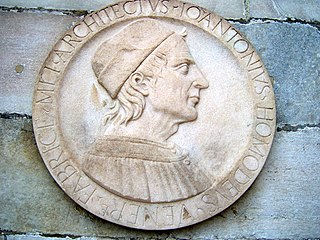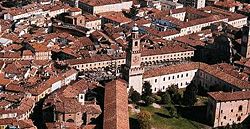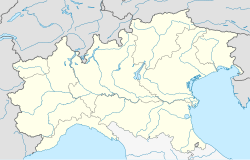
The House of Sforza was a ruling family of Renaissance Italy, based in Milan. They acquired the Duchy of Milan following the extinction of the Visconti family in the mid-15th century, Sforza rule ending in Milan with the death of the last member of the family's main branch in 1535.

Vigevano is a town and comune in the province of Pavia, Lombardy in northern Italy. A historic art town, it is also renowned for shoemaking and is one of the main centres of Lomellina, a rice-growing agricultural district. Vigevano received the honorary title of city with a decree of Duke Francis II Sforza on 2 February 1532. It is famed for its Renaissance Piazza Ducale in the centre of the town.

Ludovico Maria Sforza, also known as Ludovico il Moro, and called the "arbiter of Italy" by historian Francesco Guicciardini, was an Italian nobleman who ruled as the Duke of Milan from 1494 to 1499.

Cecilia Gallerani was the favourite and most celebrated of the many mistresses of Ludovico Sforza, known as Lodovico il Moro, Duke of Milan. She is best known as the subject of Leonardo da Vinci's painting The Lady with an Ermine. While posing for the painting, she invited Leonardo, who at the time was working as court artist for Sforza, to meetings at which Milanese intellectuals discussed philosophy and other subjects. Cecilia herself presided over these discussions.

Gian Giacomo Trivulzio was an Italian aristocrat and condottiero who held several military commands during the Italian Wars.

The Castello Sforzesco is a medieval fortification located in Milan, Northern Italy. It was built in the 15th century by Francesco Sforza, Duke of Milan, on the remnants of a 14th-century fortification. Later renovated and enlarged, in the 16th and 17th centuries it was one of the largest citadels in Europe. Extensively rebuilt by Luca Beltrami in 1891–1905, it now houses several of the city's museums and art collections.

Beatrice d'Este was Duchess of Bari and Milan by marriage to Ludovico Sforza. She was one of the most important personalities of the time and, despite her short life, she was a major player in Italian politics. A woman of culture, an important patron, a leader in fashion: alongside her illustrious husband she made Milan one of the greatest capitals of the European Renaissance. With her own determination and bellicose nature, she was the soul of the Milanese resistance against the enemy French during the first of the Italian Wars, when her intervention was able to repel the threats of the Duke of Orléans, who was on the verge of conquering Milan.

Bianca Maria Visconti also known as Bianca Maria Sforza or Blanca Maria was Duchess of Milan from 1450 to 1468 by marriage to Francesco I Sforza. She was regent of Marche during the absence of her spouse in 1448. She served as Regent of the Duchy of Milan during the illness of her spouse in 1462, as well as in 1466, between the death of her spouse and until her son, the new Duke, who was absent, was able to return to Milan to assume power.

Giovanni Antonio Amadeo was an Italian Renaissance sculptor of the Early Renaissance, architect, and engineer. He dominated late fifteenth-century Lombard architecture and sculpture.

The Certosa di Pavia is a monastery and complex in Lombardy, Northern Italy, situated near a small town of the same name in the Province of Pavia, 8 km (5.0 mi) north of Pavia. Built in 1396–1495, it was once located on the border of a large hunting park belonging to the Visconti family of Milan, of which today only scattered parts remain. It is one of the largest monasteries in Italy.

Lucrezia Crivelli was a mistress of Ludovico Sforza "il Moro", Duke of Milan. She was the mother of Sforza's son, Giovanni Paolo I Sforza, Marquess of Caravaggio. Crivelli has been thought to be the subject of Leonardo da Vinci's painting, La belle ferronnière.

Vermezzo is a comune (municipality) in the Metropolitan City of Milan in the Italian region Lombardy, located about 15 kilometres (9 mi) southwest of Milan.
Lucrezia Landriani was the mistress of Galeazzo Maria Sforza, Duke of Milan, and the mother of his renowned illegitimate daughter, Caterina Sforza, Lady of Imola, Countess of Forlì. Lucrezia had three other children by the Duke, and two by her husband.

Galeazzo da Sanseverino, known as the son of Fortuna, was an Italian-French condottiere and Grand Écuyer de France; Marquis of Bobbio, Count of Caiazzo, Castel San Giovanni, Val Tidone and Voghera. He was first the favorite of Ludovico il Moro and Beatrice d'Este, then of Louis XII and Francis I of France, as well as a sworn enemy of Gian Giacomo Trivulzio.
On the other hand the Duke of Milan
called and gave the general cane
to Maria Galeazo, and captain
did it of his people on the saddle,
who riding then from hand to hand,
with the banner in the wind of the snake,
honor and glory of Lombardy,
with many great gentlemen in company.

Visconti Park was the private park of the Visconti and Sforza families, lords, and dukes of Milan. Located in Lombardy, northern Italy, it extended between the Pavia Castle and the Pavia Charterhouse. It covered an area of about 2,200 hectares (22 km2) and was encircled by walls about 25 kilometres (16 mi) in length. It was founded in 1360 by Galeazzo II Visconti and enlarged by his son Gian Galeazzo. Its decay began in 1525 with the damages inflicted during the Battle of Pavia. Today, the park's area mainly serves agriculture purposes, while some portions are nature reserves.

The Visconti Castle, or Castello Visconteo, is a castle in the town of Cusago near Milan, Lombardy, Northern Italy. It was built in the 14th century by Bernabò Visconti and used as a hunting lodge by him and other Visconti family members. The castle underwent significant changes in the Renaissance period; today, it is in neglected conditions.

The Visconti Castle of Abbiategrasso is a medieval castle in Abbiategrasso, Lombardy, northern Italy. It was among the first Visconti castles built according to their typical quadrangular layout. In the 14th and 15th centuries, it was one of the preferred residences of the duchesses of Milan of the Visconti and Sforza houses. Today, the castle's surviving part serves as the seat of the municipality of Abbiategrasso.

Leonardo is a historical drama created by Frank Spotnitz and Steve Thompson. The series was produced by Italian Lux Vide in collaboration with Rai Fiction, Sony Pictures Entertainment, with Frank Spotnitz's Big Light Productions and Freddie Highmore's Alfresco Pictures in association with France Télévisions and RTVE.

The Visconti-Sforza Castle or Sforza Castle of Galliate is a medieval castle in Galliate, Piedmont, Northern Italy. It was erected in the 15th century by the Sforza, dukes of Milan, on a previous fortification built by their progenitors Visconti.

The Visconti Castle of Pavia is a medieval castle in Pavia, Lombardy, Northern Italy. It was built after 1360 in a few years by Galeazzo II Visconti, Lord of Milan, and used as a sovereign residence by him and his son Gian Galeazzo, first duke of Milan. Its wide dimensions induced Petrarch, who visited Pavia in the fall of 1365, to call it "an enormous palace in the citadel, a truly remarkable and costly structure". Adjacent to the castle, the Visconti created a vast walled park that reached the Certosa di Pavia, a Carthusian monastery founded in 1396 by the Visconti as well and located about 7 kilometres (4.3 mi) to the north.

























